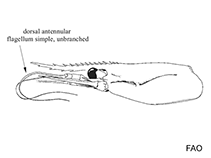Campylonotus semistriatus Bate, 1888
Razor shrimp| Native range | All suitable habitat | Point map | Year 2050 |

|
| This map was computer-generated and has not yet been reviewed. |
| Campylonotus semistriatus AquaMaps Data sources: GBIF OBIS |
Upload your photos
Google image | No image available for this species;
drawing shows typical species in Campylonotidae.
Google image | No image available for this species;
drawing shows typical species in Campylonotidae.
Classification / Names Common names | Synonyms | CoL | ITIS | WoRMS
Malacostraca | Decapoda | Campylonotidae
Environment: milieu / climate zone / depth range / distribution range Ecology
Benthic; depth range 30 - 2086 m (Ref. 87391). Temperate; 33°S - 64°S, 78°W - 24°W
Distribution Countries | FAO areas | Ecosystems | Occurrences | Introductions
Southeast Pacific, Southwest Atlantic and Antarctic Atlantic: Chile, Argentina and Falkland Islands.
Length at first maturity / Size / Weight / Age
Maturity: Lm ? range ? - ? cm
Minimum depth from Ref. 79465. Abundant in sublittoral areas below 100 m (Ref. 106803). Restricted to channels and fjords (Ref. 106804). Lives in muddy sand bottoms (Ref. 101581). In general, members of the family Campylonotidae are carnivorous (Ref. 107109).
Life cycle and mating behavior Maturity | Reproduction | Spawning | Eggs | Fecundity | Larvae
Members of the order Decapoda are mostly gonochoric. Mating behavior: Precopulatory courtship ritual is common (through olfactory and tactile cues); usually indirect sperm transfer.
Main reference
References | Coordinator | Collaborators
Gorny, M. 1999. (Ref. 87391)
IUCN Red List Status (Ref. 130435)
CITES status (Ref. 108899)
Not Evaluated
CMS (Ref. 116361)
Not Evaluated
Threat to humans
Harmless
Human uses
| FishSource |
Tools
More information
Age/Size
Growth
Length-weight
Length-length
Morphology
Larvae
Abundance
Growth
Length-weight
Length-length
Morphology
Larvae
Abundance
Internet sources
BHL | BOLD Systems | CISTI | DiscoverLife | FAO(Publication : search) | Fishipedia | GenBank (genome, nucleotide) | GloBI | Gomexsi | Google Books | Google Scholar | Google | PubMed | Tree of Life | Wikipedia (Go, Search) | Zoological Record
Estimates based on models
Preferred temperature
(Ref. 115969): 2.6 - 6.5, mean 4.3 (based on 122 cells).



